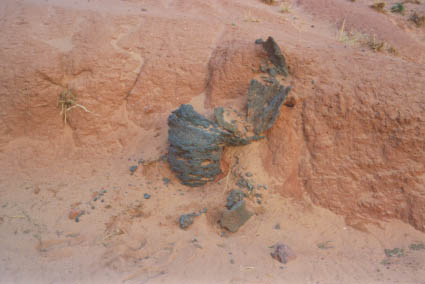 |
||
| This furnace was exposed for just over a year before collapsing, and indicates one of the many different furnace structures used for iron-smelting in Nigeria. A base containing six radial tuyères (air pipes) was also noted here. |
 |
||
| This furnace was exposed for just over a year before collapsing, and indicates one of the many different furnace structures used for iron-smelting in Nigeria. A base containing six radial tuyères (air pipes) was also noted here. |
History: Most of the survey work for this project was undertaken between 1982 and 1986. Work began around the quartzite Kazaure hills in northern Nigeria, where numerous kirya trees (Prosopis africana) trees once provided charcoal for smelting, mainly in Late Iron Age shaft furnaces. The next surveys concentrated on the peripheries of large laterite mesas - some of the world's most ancient land-surfaces dating back several million years - to survey much higher densities of iron-smelting ruins, mainly Early Iron-Age bowl furnaces. Later surveys roamed vast areas following oral tradition and other leads to locate smelting in a whole range of other environments. Finds included the Siri furnaces (below) and two groups of over 200 shaft mines up to 15 m deep. Finds, such as those in Yankari National Park (below), are still occurring; and an African Legacy video includes more data.
Ceramic analyses: Within the Kano area, attempts to collect pottery sherds for seriation analyses by computer were thwarted by the deposition of taki (manure and household waste including sherds) on the in-fields of the close-settled zone, which is under permanent cultivation. Seriation analyses of spatially discrete collections rely on the lateral shift of settlement over time; and this was being disguised by the taki, by slow rates of ceramic change and by a paucity of decoration and form variables. Although one very tediously detailed survey by a USA researcher discovered one possible chronological variable in the fabric (inclusion of grog), a more cost-effective approach was to collect from specific land-use sites over a very extensive area. Such sites included rock-shelters, iron-smelting ruins, gullies, fields, deserted settlements and today's occupied settlements. These then provided an approximate chronological framework against which sherd variables could be easily compared to sort out their lenticular distribution over time and space. As a technique for pioneering surveys in Africa, this was both rapid, simple, effective and resource efficient.
| This furnace ruin at Siri was hidden inside a stone structure within a house on a hilltop during the unstable conditions of the C19thj jihad (holy war). Many of northern Nigeria's iron-smelters were Maguzawa (magicians) who 'played with fire' and maintained other pre-Islamic practices. Note the baobab trees (Adansonia digitata) in the background: these acted as a famine food, provided rope, medicine and helped curdle whey. Local people say that Allah was angry with this tree and so planted it upside-down with its roots in the air. |  |
| Shaft furnace ruins in Yankari National Park, Nigeria
were only 'discovered' recently, and indicate the vast potential of Africa's
visible archaeology. This picture has been used as the cover for African
Legacy's video on early art, iron-smelting and settlement wall construction
in Nigeria.
For enquiries: e-mail: explore@africanlegacy.info |